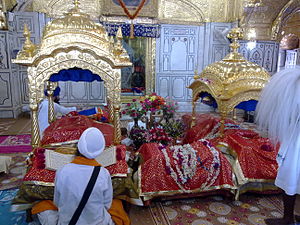|
Hazur Sahib
Hazur Sahib[a] (Hazūrī Sāhib; lit. 'presence of the sahib/master'), also known as Takht Sachkhand Sri Hazur Abchalnagar Sahib, is one of the five takhts (religious centres) in Sikhism. The gurdwara (Sikh house of worship) was built between 1832 and 1837 by Maharaja Ranjit Singh (1780–1839).[1] It is located on the banks of the Godavari River at the city of Nanded in the state of Maharashtra, India. The structure is built at the place where Guru Gobind Singh Ji departed physical form and united with the eternal light. The gurdwara within the complex is known as Sach-Khand (Realm of Truth). The inner room of the gurdwara is called the Angitha Sahib and is built over the place where Gobind Singh was cremated in 1708.[2] History Hazur Sahib marks the site where Guru Gobind Singh ji had his camp in 1708. The Guru held his court and congregation here and was convalescing after being attacked by two would-be assassins. One of the attackers stabbed the Guru, and was killed by him with a single stroke of his talwar (curved sword). The other was killed by his followers as he tried to escape. The Guru's wound was deep, but initially healed after being stitched by an English surgeon sent by Bahadur Shah I, who served as his doctor, and Dara Shikoh before him.[3] However the wound re-opened a few days later when the Guru was stringing a bow for one of his Sikhs and the Guru merged into the Primal (Joti Jot) after declaring the Guru Granth Sahib as his successor.[4] The Sikhs built a room over the platform where Guru Gobind Singh Ji would sit while holding his court and installed Guru Granth Sahib Ji on it. They called it Takhat Sahib. Guru Gobind Singh Ji, while conferring Guruship to Guru Granth Sahib Ji, had himself named Nanded as "Abchalnagar" (literally "Steadfast city") after the first word of a hymn read at random on the occasion. In October 2008, the 300th-anniversary celebration of the Guruship of Guru Granth Sahib ji took place here. This site is now one of five Takhats which are places of primary importance to the Sikhs. The other four takhats are: Sri Akal Takht Sahib at Amritsar, Takhat Sri Keshgarh Sahib at Anandpur, Takhat Sri Patna Sahib in Bihar and Takhat Sri Damdama Sahib in Talwandi Sabo, Bathinda, Punjab. Sachkhand (literally "region of Truth") had been used by Guru Nanak Sahib Ji to mean the abode of God. Ranjit Singh had the present building of the Takhat Sahib constructed with money, artisans, and labor sent from Punjab during the early 1830s. Around the same time, the 3rd Nizam of Hyderabad Kingdom a Muslim ruler of the Deccan Region raised a contingent of Northern Sikhs as part of his army. Most of these men settled permanently in Hyderabad State and also few Hindus of the Deccan embraced Sikhism in the 19th century.[citation needed] The control of Takhat Sachkhand Sri Hazoor Sahib, which had formerly passed into the hands of Udasi Sikh priests was regained by the Sikhs under the influence of the Singh Sabha Movement of the late nineteenth century. Some of the 'rituals and ceremonies connected with working' are peculiar to this Takhat Sahib. In 1956 an Act was passed by the legislature of Hyderabad under which the management of the Takhat Sahib and other historical Gurdwaras was legally placed under a 17-member Gurudwaras Board and a five-member Managing Committee. The Takht houses both the Sri Guru Granth Sahib ji and the Sri Dasam Granth. This follows the pattern of Takht Sri Patna Sahib. Nanded is the city where Baba Banda Singh Bahadur had his ashram and Baba Banda Singh started his journey of Khalsa victory.[citation needed] The shrine differs from other historical places of Sikh worship, here all ancient customs which were practised at the time of the Guru are still practiced, for example, sandal-wood tilak is still applied on the foreheads of priests and local devotees. While all the functions are carried out by the priests in the outer room, the inner room is a vault that houses valuable objects, weapons and other personal belongings of the Guru. No one except the head priest can enter the vault.[5] Heritage conservationSikh historians and scholars have raised alarms regarding the plight of Sikh historical heritage within the Takht Hazur Sahib complex.[6] Many historical structures have been destroyed by the takht's management committee, much to the dismay of a vocal section of Sikhs who pleaded for these sites to be preserved in their original state.[6] Sharad Chalikwar, a consultant engineer, and Kiran Kalamdani, a restoration architect, had come up with restoration plans to save the historical buildings but Hazur Sahib's management committee ended-up demolishing the buildings under the guise of Kar Seva renovations.[6] The buildings that were destroyed include:[6]
300th anniversary celebrationsIn 2008, the 300th Gurudomship ceremony of Guru Granth Sahib and 300th Joti Jot anniversary of Guru Gobind Singh were celebrated on a large scale at Hazoor Sahib, Nanded. Manmohan Singh, then Prime Minister of India, addressed the Sath-Sangat at the main function.[citation needed] Laser fountain show A laser show at Gobind Bagh near the main gurdwara briefly describes the lives of the ten Gurus. It is the second largest laser show in Asia.[citation needed] Historical gurdwaras in Nanded
List of Jathedars
Kirtan Maryada Ragis at Hazur SahibBhai Jagat Singh (1917–1978) was an eminent Ragi who did Seva at the Takhat from AD 1934 to 1978 (till death). Gallery
See alsoNotes
References
Further reading
External links |
||||||||||||||||||||||||||||||||||||||||||||||||||||||||||||||||||||||||||||||||||||||||||||||||||||||||||||||||||||||||||||||||||||||||||||||||||||||||||||||||||||||||||||||||||||||||||||||||||







